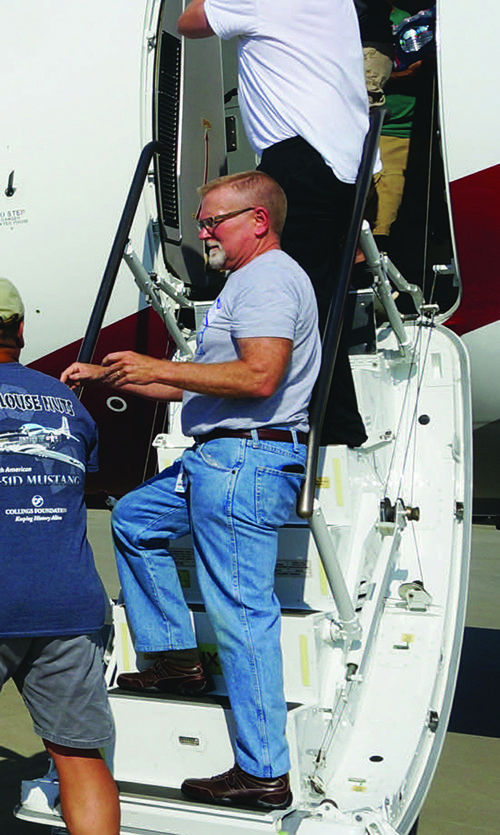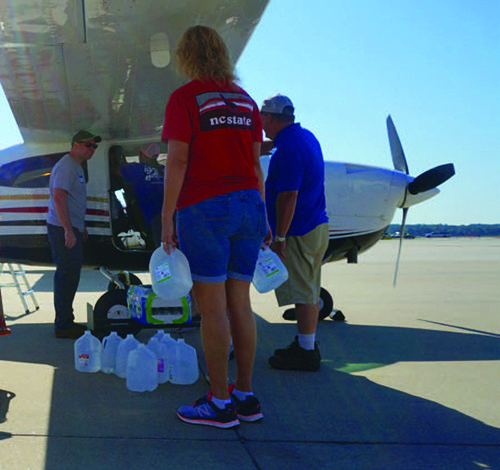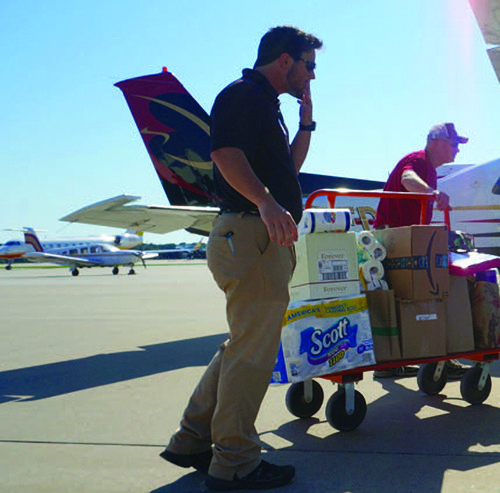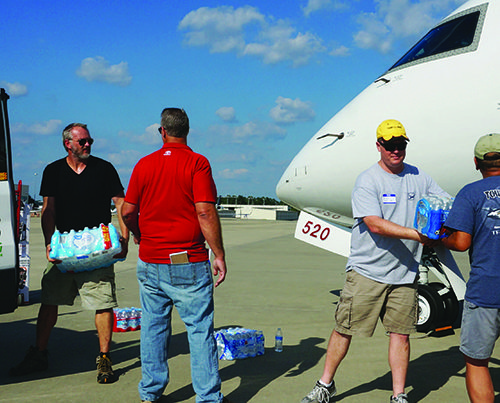In September 2018, Hurricane Florence dumped 35 inches of rain on the Carolinas, with winds gusting up to 130 mph. The Category 4 storm created widespread flooding that closed major freeways and other roads for days after landfall, completely cutting off access for 120,000 people in Wilmington, NC, and many more in surrounding communities.
In September 2018, Hurricane Florence dumped 35 inches of rain on the Carolinas, with winds gusting up to 130 mph. The Category 4 storm created widespread flooding that closed major freeways and other roads for days after landfall, completely cutting off access for 120,000 people in Wilmington, NC, and many more in surrounding communities.
Those numbers are extreme. But even more remarkable are the numbers posted by Operation Airdrop, a volunteer disaster response organization that flew in desperately needed supplies. Over six days, it executed 517 missions to deliver 284,000 pounds of water, diapers, batteries, medication, hot meals and other vital provisions. Thanks to social media posts, news stories and word of mouth, the organization had the help of 150 pilots and more than 900 land-based workers. And they all volunteered their time to help communities devastated by Florence.
Not bad for a one-year-old organization that formed organically in the wake of Houston’s Hurricane Harvey in 2017. With just eight volunteer employees, Operation Airdrop is at the ready to help when need arises.
|
Project: Supporting Hurricane Relief Location: Raleigh-Durham (NC) Int’l Airport Volunteer Response Organization: Operation Airdrop Relief Effort: 517 flights with 284,000 pounds of crucial supplies such as water, diapers, batteries, medication & hot meals after Hurricane Florence in Sept. 2018 On-Site Volunteers: 150 pilots & 900+ land-based workers In-Kind Support: TAC Air donated use of its on-ramp facility & provided fuel at cost Airfield Impact: Airport’s daily flight operations tripled during relief efforts Mitigation Strategies: Operation Airdrop worked with approach control to develop special VFR reporting procedure to manage inbound traffic from its pilots; TAC Air provided additional security & supplied safety escorts for volunteers working on the ramp For More Information: Visit www.operation-airdrop.com or email the team at contact@operation-airdrop.com |
Since Harvey, Operation Airdrop has provided relief in the aftermath of Hurricane Irma in Florida, Maria in Puerto Rico and Florence in North Carolina. In each case, the local airport and its tenants provided critical support.
Feet on the Ground & in the Air
The team that descended on Raleigh-Durham International Airport (RDU) after Florence included Ethan Garrity, the organization’s assistant director of operations, and Brian Kelly, its executive director.
Both were on the ground in Texas when Operation Airdrop President Doug Jackson founded the organization—literally on the fly—in response to massive flooding in the Houston area. Kelly’s background as an air traffic controller and a navigator for HC-130 search and rescue missions was invaluable for helping set up operations for response efforts. He was part of the first supply run in Houston, which used a Cessna 421 to fly in a minivan load of supplies for the Salvation Army. Throughout the next week, Operation Airdrop and other organizations flew 120+ flights into Hawthorne Field Airport in Kountze, TX. Its diverse volunteer fleet even included a DC-3 that was used in the Berlin Airlift.
Meanwhile, Garrity, an EMT and pilot who has done stints in both the U.S. Army and Air Force Reserves, set up a command center at Business Air, a fixed base operator (FBO) at Denton Enterprise Airport.
While he greatly appreciates all the airports and airfield tenants that have helped with relief operations, he considers the facilities made available after Hurricane Florence the best yet. “RDU really was the zenith of our capabilities to date. It was a perfect storm,” Garrity says, no pun intended.
Part of the serendipity was a nearly vacant building right on RDU’s ramp. Because TAC Air was undergoing renovations at the time, a large part of the FBO’s building was vacant. That’s where Daniel Mansfield, general manager of TAC Air at RDU, came into the picture.

The day after Florence made landfall, he received a call about Operation Airdrop needing space to set up its command center. Wanting to help, Mansfield gave the go-ahead to use TAC Air’s facility. “I had no idea what we were really talking about at first,” he acknowledges. “I knew that [providing access to] this area would keep the operation away from the rest of the business. But I had no clue what kind of operation it was going to turn out to be. It went from me thinking it was probably going to be 20 volunteers, to something much bigger than that.”
Basic Requirements
Wherever a hurricane hits, Operation Airdrop looks for support from the local airport and airfield tenants. Here’s what the organization needs to do what it does best:
-
Facilities
Relief efforts are large-scale operations; so the organization needs a large hangar, ideally with ramp access, for supply drops and subsequent sorting, packing and weighing. “We don’t want to truck stuff to load airplanes,” Garrity says. “Part of the ability to move quickly is that it gets weighed and sealed off and then takes off.”
On site, the team sets up technology to support dispatching/distribution plans and help coordinate volunteers. At RDU, it used a network of tablets supplied by Microsoft.
-
Flexibility
By nature, hurricanes are unpredictable. Mansfield says the most important thing for everyone involved is the willingness to adapt to changing situations. “It’s not going to always go as you planned, and you have to be OK with that. We adapted to what we could do and what we couldn’t do,” he says. “If you come in with a plan saying ‘This is exactly how it’s going to be,’ your sand castle is going to get kicked over.”
-
Fuel
Multiple days of around-the-clock missions require a lot of fuel. Because Operation Airdrop pilots donate their time, and pay for expenses out of pocket, fuel costs are a top concern. In addition to offering use of its on-ramp facility, TAC Air at RDU provided fuel at cost.
-
Facilitation
Communication and coordination with all areas of the airport are essential, stresses Garrity. While commercial and general aviation airports have different levels of bureaucracy, Operation Airdrop staff members “speak the language” of both. In fact, all eight volunteer employees have aviation backgrounds. This allows them to communicate effectively with operations staff, air traffic controllers, TSA officials and airport authorities to make sure everyone is in the know and can play their respective roles to facilitate relief efforts.
-
Focus on Safety
With hundreds of extra aircraft and volunteers on site, ramps can get cluttered. Mansfield knows that can turn into a dangerous situation if inexperienced individuals are on the ramp near moving aircraft, turning props, running engines and other dangers some volunteers don’t know to look out for. “Safety still has to be No. 1,” he stresses. “You have to make sure they get to the aircraft and back, and they don’t accidentally hit or run into anything.” He advises diligent education and escorting even if that slows the process slightly. “You never want anybody who has a good heart and is trying to come out here and do good to get injured.”

It Takes a Village
Garrity says that the blueprint for disaster relief changed after Hurricane Katrina, when people realized that the government may not come right away. Today, communities are much more open to the idea of grassroots disaster relief, he notes. “There’s a lot less bureaucracy at that level, which means that it’s a lot of faith and trust.”
 The leadership team’s qualifications and industry connections engender confidence and facilitate cooperation from airports and regulators. “We’ve noticed that most small grassroots organizations don’t possess the same level of access as Operation Airdrop, simply because they don’t know how to speak the languages,” Garrity explains. “We’ve been able to streamline a logistics source… and have people like Brian [Kelly] and others who know how to call the airport authority and FBO. Instead of just showing up and being a pain in someone’s butt, we let them know what we’re doing and get them involved.”
The leadership team’s qualifications and industry connections engender confidence and facilitate cooperation from airports and regulators. “We’ve noticed that most small grassroots organizations don’t possess the same level of access as Operation Airdrop, simply because they don’t know how to speak the languages,” Garrity explains. “We’ve been able to streamline a logistics source… and have people like Brian [Kelly] and others who know how to call the airport authority and FBO. Instead of just showing up and being a pain in someone’s butt, we let them know what we’re doing and get them involved.”
 At RDU, Mansfield says he considered it his job to help Operation Airdrop provide relief services without causing any significant operational or regulatory issues for the airport. He and his staff consequently provided extra security and ramp escorts. Mansfield credits the RDU operations staff, airport security personnel, air traffic controllers and TSA with being flexible and accommodating.
At RDU, Mansfield says he considered it his job to help Operation Airdrop provide relief services without causing any significant operational or regulatory issues for the airport. He and his staff consequently provided extra security and ramp escorts. Mansfield credits the RDU operations staff, airport security personnel, air traffic controllers and TSA with being flexible and accommodating.
And there was quite a bit to accommodate. Operation Airdrop tripled RDU’s daily operations with its response missions. To mitigate the impact, Kelly leveraged his air traffic control experience and worked with on-site approach control to establish a VFR reporting procedure that helped manage inbound traffic.
Beyond the Eye of the Hurricane
So far, Operation Airdrop has focused exclusively on providing assistance after hurricanes. Other flooding in the U.S. has been handled more efficiently by local organizations, explains Garrity.

In April, however, he met with Kenmore Air in Seattle. As the nation’s largest seaplane operator, it regularly practices moving supplies in and wounded out of disaster areas. Garrity was asked to help run a drill for a West Coast seismic event—preparing for tsunami-related flooding associated with an 8.1 to 8.3 earthquake of one to three minutes.
Since Hurricane Florence, Operation Airdrop has been relatively quiet. Although its staff would love to be permanently out of work, they anticipate needing to execute at least one relief effort every year. Based on their track record, they’ll be ready to go when the need arises.
Editor’s Note: As this issue was going to press, Operation Airdrop was already back at work, providing relief after Hurricane Dorian.


 facts&figures
facts&figures

